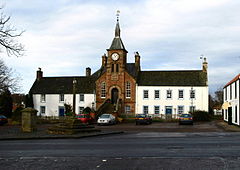Gifford, East Lothian
| Gifford | |
|---|---|
 Town Hall, Gifford |
|
| Gifford shown within East Lothian | |
| Population | 700 |
| OS grid reference | NT534680 |
| Civil parish | |
| Council area | |
| Lieutenancy area | |
| Country | Scotland |
| Sovereign state | United Kingdom |
| Post town | HADDINGTON |
| Postcode district | EH41 |
| Dialling code | 01620 |
| Police | Scottish |
| Fire | Scottish |
| Ambulance | Scottish |
| EU Parliament | Scotland |
| UK Parliament | |
| Scottish Parliament | |
Gifford /ˈɡɪfərd/ is a village in the parish of Yester in East Lothian, Scotland. It lies approximately 4 miles south of Haddington and 25 miles east of Edinburgh.
It groups around the Colstoun Water (locally called Gifford Water) at the junction of the B6369 and B6355 surrounded by rural farmland.
The village takes its name from the 13th-century Sir Hugo de Giffard of Yester, whose ancient Scoto-Norman family possessed the baronies of Yester, Morham, and Duncanlaw in Haddingtonshire, and Tayling and Poldame in the counties of Perthshire and Forfar.
The first Hugo de Giffard's grandson, Hugh de Giffard, was a noted magician who built Yester Castle (half a mile south-east of the present-day Yester House), the ruins and an underground chamber (the 'Goblin Ha') of which can be seen in Yester Wood. The same Hobgoblin Hall featured in the poem "Marmion" by Walter Scott.
The Mercat Cross was built in 1780 and is still standing in the centre of the village.
The initial chief industry in the town was the paper mill, which was once the source of the Bank of Scotland's bank notes. However, this mill closed in the late 18th century and since then the village has largely been residential and supported local farming communities, although a pottery, known as Castle Wynd Pottery, operated at Gifford for a short time in the 1950s.
...
Wikipedia

